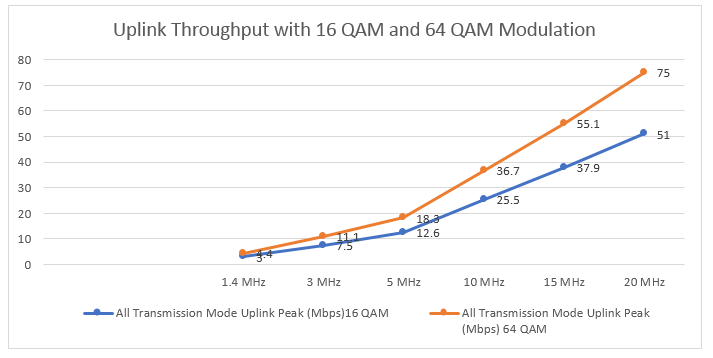LTE FDD System Capacity and Throughput Calculation
LTE System support for flexible bandwidth like 1.4 MHz, 3 MHz ,5 MHz,10 MHz , 15 and 20 MHz and this bandwidth is the major contributor system capacity. There are some other parameter which affect the system capacity of an LTE eNodeB and given below
- Channel Bandwidth
- MIMO Antenna Configuration
- Modulation Coding Scheme
- UE radio Condition (SNR, CQI etc.)
- Duplex Mode e.g. FDD, TDD
In this post , we will find out the peak eNodeB capacity (Mbps) for different channel bandwidth supported in LTE system. To start with lets first get some idea about resource block (RB) in a LTE system and how it is related to channel bandwidth. In LTE one Resource Block is about 180 KHz and a 20 MHz LTE system has about 100 Resource Blocks. The no. of Resource Block reduce as channel bandwidth reduces. No. of Resource Block against each channel bandwidth is given below
| Channel Bandwidth | 1.4 MHz | 3 MHz | 5 MHz | 10 MHz | 15 MHz | 20 MHz |
|---|---|---|---|---|---|---|
| Occupied Bandwidth | 1.08 MHz | 2.7 MHz | 4.5 MHz | 9 MHz | 13.5 MHz | 18 MHz |
| No. of Sub carrier | 72 | 180 | 300 | 600 | 900 | 1200 |
| No. of Resource Block | 6 | 10 | 25 | 50 | 75 | 100 |
For any system throughput is calculated as symbols per second. Further it is converted into bits per second depending on the how many bits a symbol can carry. Let’s consider LTE system with 20 MHz FDD mode , there are 100 Resource Blocks and each Resource block have 12x7x2=168 Symbols per ms in case of Normal CP. So there are 16800 Symbols per ms or 16800000 Symbols per second or 16.8 Msps. If modulation used is 64 QAM (6 bits per symbol) then throughput will be 16.8×6=100.8Mbps for a single antenna port.
If we consider a 2×2 MIMO system then this throughput will be double i.e. 100.8×2= 201.6 Mbps and with 4×4 MIMO system then throughput is about 100.8×4= 403.2 Mbps. In LTE these is 25% of overhead for Controlling and signalling like Reference Signal, PSS,SSS and PBCH etc. So the effective throughput will be 300 Mbps. The 300 Mbps number is for downlink and not valid for uplink.
In uplink we have only one transmit chain at UE end so no MIMO benefits. So with 20 MHz we can get Maximum of 100.8 Mbps as calculation shown above with single antenna. After considering 25% of overhead of SRS, PUCCH, PRACH etc. we get 75Mbps in uplink. For uplink there are certain constraints about modulation, this 75 Mbps throughput number is to be considered with 64 Modulation support at uplink. Most of eNodeB does support 64 QAM in uplink but few UE only support 16 QAM as maximum modulation in uplink.
In similar way we can calculate the throughput of other channel bandwidth and the calculated number is provided below. This value are after considering overhead considering FDD duplexing mode with different transmission modes and referred from 3GPP document 36.213, Table 7.1.7.1-1, Table 7.1.7.2.1-1 and Table 7.1.7.2.2-1
Throughput Thumb Rule
From the above table and below graphs get a number of thumb rules for the throughput, Like when bandwidth is reduced to half then throughput is also reduce by half in same transmission mode and when we consider same channel bandwidth then MIMO throughput is double of SISO throughput .
Below is a good document can be refereed for detailed calculation.





